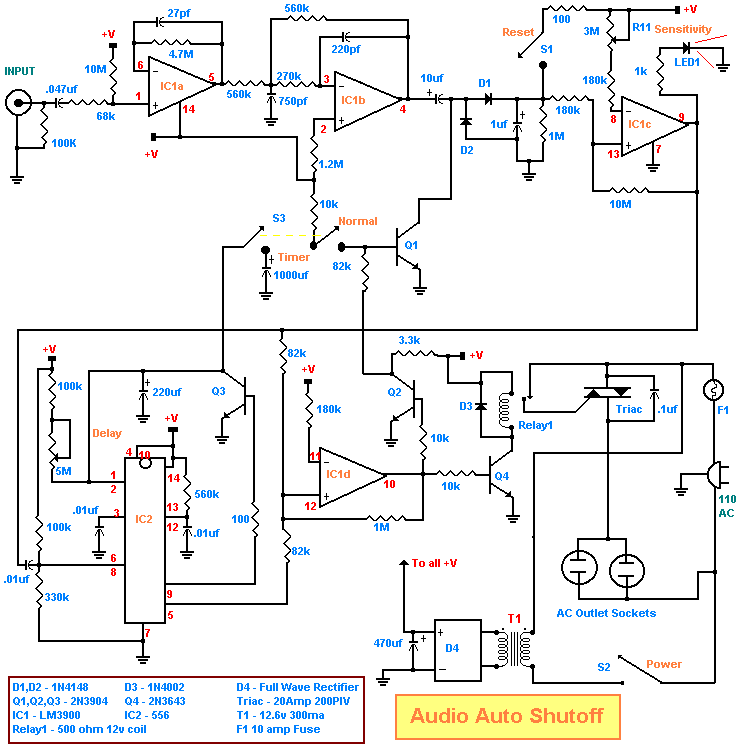Audio Auto Shutoff
I have had many requests to design or provide circuits for graduation projects. Yes, I had to build a graduation project too before receiving my degree. Even though I have always refused to design circuits for this situation, I thought it might be helpful for you to see what I built for my project many years ago when I graduated in 1978. I will also provide a more detailed description of the circuit than I normally do. Hopefully, this may help some of you with your projects.
The purpose of this circuit is to automatically turn off any device plugged into its power outlets after a certain period of time. Shutoff is activated by an absences of an audio signal or by a standard timer function. This unit would be connected to speaker terminals of a stereo system, tape outputs, TV earphone jack or audio outputs etc. Once the audio signal drops below a predetermined level a timer function will turn off any device powered by the outlets on the back of this unit. For example, if you like to fall asleep listening to your CD player. This unit could be hooked up to your speaker terminals. After the CD is done playing the audio signal would drop below the threshold value and the unit would turn off your stereo system after a certain timer interval had passed and therefore you would not have to worry about falling asleep and having your stereo being on all night. This controller can also be used as a standard timer control without the audio input and turn devices off after a preset time interval. The outlets can handle loads of up to 1200 watts and the unit is fused with a 10 amp fuse for protection.
This is how the unit works. The audio signal goes into IC1a for amplification and filtering with a roll off occurring about 1.25khz at -6db per octave. The second stage, IC1b is a 2 pole filter with a cutoff frequency is approximately 1 khz with unity gain. The 2 stages have a combined roll off of 18db per octave to remove any noise and filter out any high frequency hiss if a radio station of TV station goes off the air. This is helpful if the audio source is either FM or TV. The filtered DC level of D1, D2 and C6 with R10 "bleeding" the charge from the capacitor C6 when the signal is not present. IC1c is used as a comparator having fast "snap action" (positive feedback) so that when the rectified signal applied to the non-inverting (+) input exceeds the level set by the sensitivity control R11, the output switches off very rapidly. When IC1c output is high (audio signal is present), LED1 is turned on and current limited by R15. IC1c output signal turns on the OR gate formed by IC1d which in turn, causes Q4 to saturate and draw current through the coil of reed relay, Relay1. With the reed relay contacts closed, gate power is applied to the triac, and power is present across the multiple AC outlets. This turns on any device connected to these sockets. When the audio signal either disappears or falls below the pre-set sensitivity threshold, comparator IC1c switches off rapidly. This action also starts one of the timers in IC2 whose output pin (pin5) keeps the OR gate operating until the timer times out. Power remains on the AC outlets. If another audio signal should appear within the time-out interval, the second timer within IC2 will generate a 5 millisecond pulse which will turn on Q3 and discharge the main timing capacitor. This resets IC2 back to zero and ensures that the last audio signal is always the one that begins the time out delay. Transistors Q1 and Q2 act as a "quench" circuit by grounding the comparator signal an instant before shutdown. This is necessary because some audio power amplifiers generate a "thump" when turned off and this may retrigger the timer and never allow the system to shutdown. Reed relay Relay1 is necessary for complete isolation between the circuit and the triac. The triac should be heat sinked. The timer function is determined by the setting of normal/timer switch S3, which disables the input circuit by turning on the "quench" transistor, Q1 and connecting the a larger capacitor in parallel with the main timing capacitor. Potentiometer R17 sets the timer delay in either case, although the range for normal and timer positions of S3 is different. To operate the unit set S3 in the normal position and both pots in the mid position and then press the rest button S1. LED1 should turn on ad any device plugged into the AC outlets should turn on. With no audio signal present the LED will go out and the unit will turn off any devices plugged into after the timer expires. The time length is set by R17. Connect an audio source to the unit and adjust the sensitivity control R11 until the LED remains on continuously. The time delay for normal is maxed out at around 20 minutes and in the timer mode it is maxed out at 2 hours.

Source:www.home.maine.rr.com






